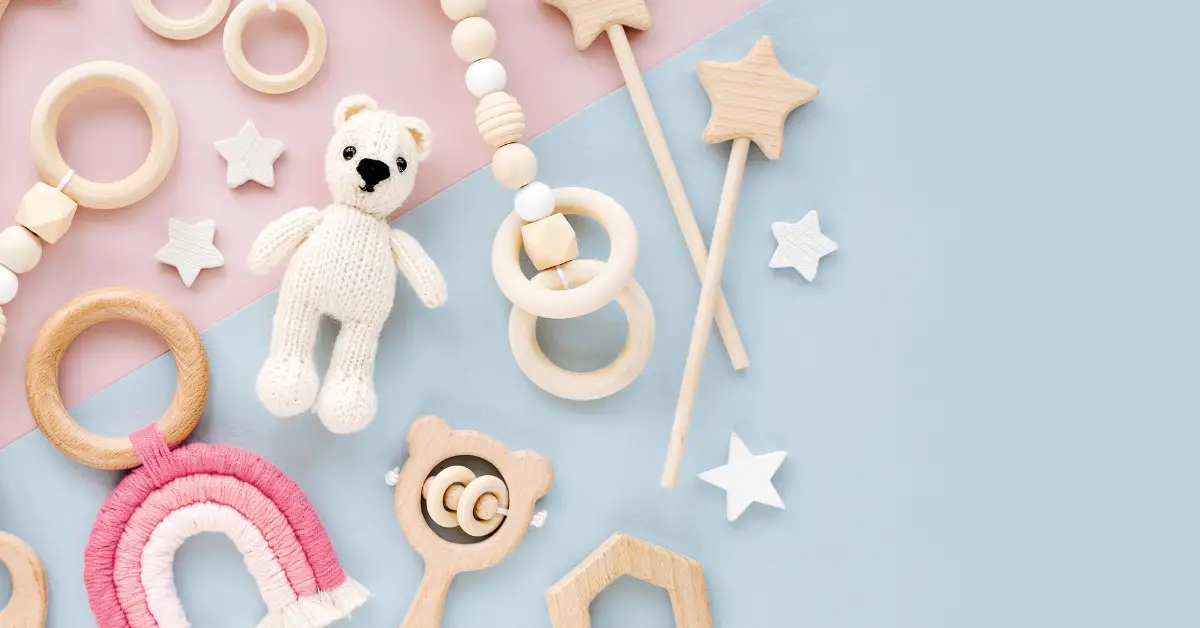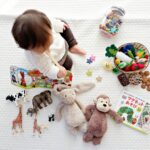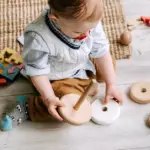When it comes to selecting fabric for baby toys, parents and caregivers should consider several factors. The fabric should be both comfortable and safe for the baby’s delicate skin, and it should be able to withstand the wear and tear of playtime.
Of course, most parents also want to find fabric that looks great and fits the style or aesthetic of their nursery. With so many options on the market, it can be difficult to determine which fabric is the best for baby toys. In this blog post, we’ll cover the essential information on the best fabric for baby toys, including the benefits and drawbacks of certain fabrics and tips for selecting the right material for your needs. With the right fabric, you can create beautiful toys that are both safe and durable.
1. Organic cotton
When it comes to the best fabric for baby toys, organic cotton is an excellent choice. Not only is it softer and more durable than conventional cotton, but it also doesn’t contain any harsh chemicals or synthetic dyes, making it a safer choice for baby toys. Organic cotton is also exceptionally breathable and absorbent, making it a great choice for baby toys that will be used for long periods of time. Best of all, organic cotton is environmentally friendly since it uses fewer resources and results in fewer greenhouse gas emissions than conventional cotton.

2. Fleece
For those looking for a more luxurious fabric for baby toys, fleece is a great choice. Fleece is incredibly soft and snuggly, perfect for cuddly stuffed animals and blankets. It’s lightweight, breathable, and durable, making it an ideal material for toys that will be handled frequently. Fleece is also easy to wash and dries quickly. Plus, it’s available in various colors and patterns, so you can easily find the perfect look for your project.
3. Bamboo Rayon
Bamboo Rayon is a great choice for baby toys because it is naturally hypoallergenic and resistant to bacteria, making it a safe and healthy option for children. It’s also incredibly soft and comfortable, making it perfect for cuddling and playing. Bamboo Rayon is also breathable, making it ideal for hot climates or children prone to overheating. Finally, it’s also durable and long-lasting, so your baby can enjoy their toys for a long time.
4. Flannel
Flannel is one of the best fabrics you can use when making baby toys. It’s incredibly soft and cozy, which makes it the perfect fabric to cuddle up with. It’s also lightweight and breathable, which makes it a great option for baby toys that may be in contact with sensitive skin. Flannel is also easily accessible and comes in a variety of colors and patterns, so you can make sure to find something that matches your baby’s style. It’s also easy to care for and machine washable, so you don’t have to worry about spending too much time taking care of it.

5. Gauze
If you’re looking for the best fabric to make baby toys, look no further than gauze. This lightweight fabric is soft and breathable, making it perfect for cuddly baby toys. It’s also very durable, so your toys will last through generations of use. Gauze is also easy to clean and maintain, so you won’t have to worry about it becoming stained or worn. Plus, plenty of beautiful colors and patterns are available, so you can make any type of toy you can imagine with gauze.

Tips for selecting the right material for making baby toys
When choosing the material for making baby toys, it is important to consider the following factors:
- Safety: The material should be non-toxic and free of any chemicals or substances that may be harmful to a baby.
- Comfort: The material should be soft and gentle on a baby’s skin.
- Durability: The material should be able to withstand the wear and tear of being played with by a baby.
- Ease of cleaning: The material should be easy to clean and maintain with water, as baby toys can get dirty quickly.
- Allergies: If the baby or anyone in the household has allergies, it is important to choose a material that is hypoallergenic.
What are the best types of infant toys made from fabric?
Some of the best types of infant toys made from fabric include:
- Soft dolls or stuffed animals: These toys are soft and cuddly, making them perfect for infants to hold and play with.
- Cloth books: Soft baby books are made of soft fabric and often feature colorful images and textures that are interesting for infants to explore.
- Sensory balls: Sensory balls are soft and squishy and often have different textures and patterns on the surface that babies can feel and explore.
- Fabric blocks: Fabric blocks are soft, lightweight blocks that infants can stack, toss, and play with. They often have different colors, shapes, and textures, providing a fun sensory experience for babies.
- Rattles: Rattles are a classic baby toy that is made of fabric, plastic, or wood and produces a soothing sound when shaken.
- Bath toys: Bath toys are soft, plush toys that are designed to float in bathwater. They provide an enjoyable tactile sensation for babies who like to play in the tub.
When choosing infant toys made from fabric, it is important to select toys that are safe, non-toxic, and free of any small parts or loose strings that may be choking hazards for infants. Additionally, the fabric should be soft and gentle on a baby’s skin, and the toys should be easy to clean and maintain.
How do I create my own fabric toys?
To create your own fabric toys, you will need the following materials:
- Fabric: Choose a soft, natural fiber such as cotton or wool for your fabric. Avoid using synthetic materials, such as polyester or nylon, as these can contain chemicals that may be harmful to a baby.
- Stuffing: Use a hypoallergenic stuffing material, such as polyester fiberfill, to give your toy a soft, cuddly texture.
- Sewing supplies: You will need a sewing machine, thread, scissors, and a needle to sew your toy together.
- Patterns: You can create your own patterns for your toys, or you can use a pre-made pattern that you can find online or in a craft store.
To make your own fabric toy, follow these steps:
- Cut out the fabric pieces: Using your pattern as a guide, cut out the fabric pieces for your toy. Be sure to cut out any embellishments, such as eyes or noses, that you will be adding to your toy.
- Sew the pieces together: Use a sewing machine or a needle and thread to sew the fabric pieces together. Be sure to leave an opening for stuffing the toy.
- Stuff the toy: Use a hypoallergenic stuffing material to fill your toy. Be sure to evenly distribute the stuffing to give your toy a plump, cuddly texture.
- Sew the opening closed: Once the toy is stuffed, use a sewing machine or a needle and thread to sew the opening closed.
- Add any embellishments: If you are adding any embellishments to your toy, such as eyes or noses, now is the time to do it. Use a needle and thread to attach the embellishments securely to the toy.
With creativity and some basic sewing skills, you can create unique fabric toys for infants to enjoy.
How to clean baby toys made of fabric, follow these steps:
- Remove any loose dirt or debris: Use a soft brush or a cloth to remove any loose dirt or debris from the toy’s surface. If the toy has batteries, remove them as well.
- Wash the toy in warm water: Fill a sink or basin with warm water and add a mild, fragrance-free laundry detergent or a cleaning solution. Place the toy in the soapy water and gently agitate it to loosen any dirt or grime. Do not use hot water or bleach to clear toys.
- Rinse the toy thoroughly: Rinse the toy thoroughly with clean water to remove any soap residue. Be sure to rinse the toy until the water runs clear.
- Air dry the toy: Do not put the toy in the dryer, as the heat can damage the fabric or cause the toy to shrink. Instead, lay the toy flat to air dry.
If the toy is particularly dirty or has a strong odor, you may need to wash it more than once to thoroughly clean it. Additionally, some toys may need machine washing, in which case you can wash them in a washing machine on a gentle cycle using a mild, fragrance-free laundry detergent. Be sure to read the care instructions for your baby’s toys and follow them carefully to ensure they are cleaned properly and remain safe and durable. Regular cleaning of toys is important for the health and safety of your child.

Summing Up
The best fabric for baby toys is one that is soft, lightweight, and durable. Natural materials like cotton, bamboo, and wool are great for this purpose, as they are soft and breathable and also easy to clean and maintain. Additionally, look for certified items to be free of any potentially hazardous materials like lead and BPA. By choosing the best fabric for your baby’s toys, you can ensure that your family’s little one is safe and comfortable as they play and engage in activities.
FAQs
Which cloth is used for making commercial stuffed toys?
Polyester fiber is commonly used as stuffing because it is soft and provides insulation. Plus, it can be cleaned quickly and dried out of the way, making it an ideal material for stuffed animals. Polyester is a durable fabric that withstands a lot of wear and tear without losing its shape or showing signs of wear and tear, and it is also mildew- and stain-resistant and made from very strong fibers.
Is polyester safe for baby toys?
Although numerous toxic and carcinogenic chemicals are used in the production of polyester fibers, the finished product is widely regarded as safe and non-toxic. This is because chemical treatments are applied to the fiber in a way that incorporates the chemicals into the fiber’s molecular structure.
That being said, it’s better to avoid using polyester if possible. Instead, opt for natural organic fabrics such as cotton, linen, silk, and wool. These fabrics are softer, more absorbent, and easier to wash than polyester.
What is the least toxic fabric?
Organic cotton is the safest and the most popular fabric for baby toys. It is grown without pesticides and has no harmful additives. Organic cotton is also hypoallergenic, which means it won’t cause allergic reactions in sensitive individuals.





